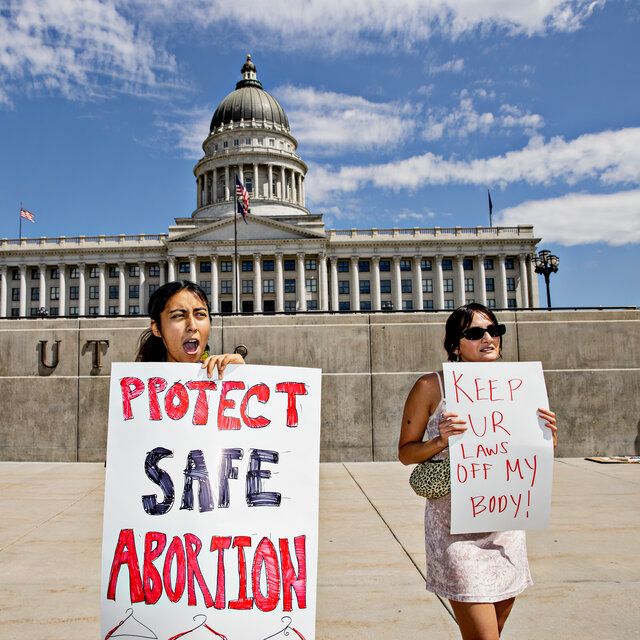Author: Vanshika Mangla, Christ University, Bangalore
ABSTRACT
The article situates the evolving legal landscape of abortion rights within recent court decisions in the United States and India. It starts with an examination of the two landmark cases in the U.S. Supreme Court—Roe v. Wade and Planned Parenthood v. Casey—that respectively laid down and substantially rewrote the constitutional right to abortion. The article then proceeds to criticize the 2022 Dobbs v. Jackson Women’s Health Organization ruling overturning Roe, returning the power to regulate abortion to individual states, who have divergent laws in this matter. It also discusses the fallout of Dobbs on healthcare providers, socio-economic and racial disparities, and the legal framework in India under the Medical Termination of Pregnancy Act. It tilts the balance between the woman’s right to choose and state interests in protection of the potential life with a more focused reappraisal of reproductive rights.
ARTICLE
This has been a controversial issue over the years, balancing a woman’s freedom of choice and the state interest in protecting potential life. Within the last few years, the legal landscape of abortion rights has been changing in a very dramatic manner. For example, the U.S. The Dobbs v. Jackson Women’s Health Organization ruling from the Supreme Court in 2022 did much to dispel the 1973 historic decision of Roe v. Wade. Against the backdrop of these emerging developments, ahead are the attempts to engage in a critical legal review of fast-changing jurisprudence by analysing recent court decisions and ascertaining broader implications for reproductive rights.
Historical Context: Roe v. Wade and Planned Parenthood v. Casey
The Supreme Court case Roe v. Wade ruled that a woman’s right to an abortion is within the protection of the Fourteenth Amendment right to personal privacy; that is fundamental and that state regulations creating an undue burden for a woman to exercise this right to have an abortion are unconstitutional. The ruling set a trimester framework in which, after the first trimester, states might regulate the procedure of abortions and prohibit them after the second trimester except where such measures are necessary for the preservation of the life or health of the mother.
Nearly two decades later, the Supreme Court returned to the issue in the 1992 decision Planned Parenthood v. Casey. While the Court reaffirmed the central holding of Roe-that women have a right to choose to have an abortion prior to viability-it jettisoned the trimester framework. It instead established the “undue burden” test, which mandated that a state could not place a substantial obstacle in the path of a woman seeking an abortion before the foetus had achieved viability. This standard gave way to increased state regulation, which in turn led to a spotty pattern of laws all over the nation that were often profoundly different from state to state.
The Dobbs Decision and Its Aftermath
The Supreme Court’s 2022 decision in Dobbs v. Jackson Women’s Health Organization unveiled another tectonic shift in abortion rights jurisprudence. Mississippi’s ban on nearly all abortions after 15 weeks of pregnancy created an express contradiction to the viability standard first established by Roe and reiterated in Casey. In a 6-3 decision, the Court upheld Mississippi’s law and struck down Roe and Casey, ending nearly 50 years of federal protection for abortion rights.
The majority opinion went back to one of the themes from Mississippi’s argument: The Constitution has nothing to say about abortion. Alito rejected the “right to privacy” underlying Roe, finding that it was not “deeply rooted in this Nation’s history and tradition.” The practical impact of the decision was to return the power over the extent of abortion regulation to the states, which gave way to a deluge of state legislation barring or protecting abortion rights.
States Limiting or Prohibiting Abortion
Many states, particularly in the South and Midwest, almost immediately began enforcing longstanding “trigger laws” written to go into effect right away in the event of a Roe reversal. The severity of these laws ranges, but most of them would effectively make almost all abortions illegal with only exceptions made for when a woman’s life is in danger or for rape and incest. Some of the most draconian laws have been enacted in states like Texas, Alabama, and Louisiana to all but ban abortion and criminalize healthcare providers. The Texas law had gone a step further ahead of the Dobbs decision: under the Texas Heartbeat Act, or Senate Bill 8, private citizens can sue anyone who either carries out, or offers any support to, an abortion following the sixth week of pregnancy. Because the case evaded judicial scrutiny by opting for the avenue of civil, not criminal, enforcement, other states are already examining that template post-Dobbs.
States Protecting Abortion Rights
On the other side, states like California, New York, and Illinois have adopted abortion protection laws with the intention of enshrining them within their borders. For its part, California has tried to become a “sanctuary state” for those who would seek to have them, passing laws specifically to protect patients and providers from out-of-state legal action. In New York, the Reproductive Health Act actually codified the right to an abortion within state law, ensuring that, in that state, access to abortion services would remain legal despite the ruling of federal courts. Some have gone further in proposing constitutional amendments that would enshrine abortion rights, and thus seek protection from future legislative changes. As an example, Vermont adopted a constitutional amendment affirming the right to reproductive autonomy, which would make it even harder for future legislatures to approve restrictive abortion laws.
Repercussions on Healthcare Providers
The Dobbs decision has created a chilling effect for healthcare providers who are now under threat of criminal prosecution in states with restrictive abortion laws. This move has put medical fraternity in a dilemma of fear, torn between what is legally doable, especially in cases of medical emergencies. Already, the uncertainty has had concrete effects, with reports of doctors delaying or denying care to patients experiencing miscarriage or other complications, fearing legal repercussions.
Socio-economic and Racial Disparities
The heaviest blows from the Dobbs decision will likely land on communities already marginalized, those of low incomes and persons of colour. This is because the harshest blows of restrictive abortion laws fall on those who cannot afford to travel to states where abortion remains legal, thus widening existing socioeconomic and racial disparities in access to healthcare. It has been documented that women turned away from abortion face higher rates of economic hardship, rising levels of poverty, and accumulating debt. This decision may also contribute to a rise in unsafe, illegal abortions, as those in prohibition states turn to alternative methods.
India’s take on Abortion Rights
The legislation governing the right to abortion in India is the Medical Termination of Pregnancy Act, which was introduced in 1971 and has undergone several amendments, the latest being in 2021. This statute allows women to terminate pregnancies under certain conditions, thereby making abortion legal but regulated.
Grounds on Which Abortions are Permissible-
Risk to the Life of the Pregnant Woman: Abortion is permissible if the continuation of pregnancy would put the woman’s life in jeopardy or entail a serious risk of grave injury to her physical or mental health.
Foetal Abnormalities: The law authorizes abortion where there is a substantial risk that the child, if born, would be seriously affected either physically or mentally by abnormalities.
Contraceptive Failure: Unintended pregnancies due to contraceptive failure also form a ground for abortion, applicable both to married and unmarried women. Indeed, this is one of the major changes introduced by the 2021 Amendment.
Rape and Incest: Pregnancies out of rape or incest are lawful grounds for an abortion.
Gestational Limits-
Up to 20 Weeks: Abortion is permissible based on the opinion of one registered medical practitioner.
20 to 24 Weeks: This allows for abortion up to 24 weeks for special categories of women under the amendment in 2021. These include survivors of rape, victims of incest, minors, and those whose marital status changes during pregnancy, like in cases of widowhood or divorce. This requires the approval of two registered medical practitioners.
The MTP Act mandates protection of the privacy of the woman undergoing the abortion. The identity and other details of the woman cannot be disclosed except to a person authorized by law. The Indian courts have basically safeguarded the right to abortion under a woman’s right to privacy and bodily autonomy. In the leading judgment of Puttaswamy v. Union of India, for example, the Supreme Court of India held in 2017 that the right to privacy was a basic right under the Constitution, which essentially means safeguards over decisions regarding one’s body, including the freedom of reproductive choices.
CONCLUSION
The Dobbs decision is a defining moment for reproductive rights in the United States. With the overturning of Roe v. Wade, the Supreme Court has changed the legal landscape most basically, resulting in a fractured country where a person’s geography dictates access to abortion. The future repercussions continue to unfold, with potential challenges to other rights related to reproductive autonomy and personal privacy.
While the right to abortion is legally recognized and protected under the MTP Act in India, it has laid down a structured framework regarding when and how abortions can legally be performed. In this light, the 2021 amendment stands as a giant step toward making access to safe abortion a reality, more so for the vulnerable groups. However, several social, economic, and infrastructural barriers still hinder the success of this right and need to be fought for the women of India so that all of them can safely and easily exercise their reproductive rights.
FAQS
Q1. What was the significance of Roe v. Wade (1973)?
A1. Roe v. Wade was a landmark U.S. Supreme Court decision that established a woman’s right to choose to have an abortion as a fundamental right protected by the Fourteenth Amendment’s right to privacy. The ruling set a framework based on pregnancy trimesters, allowing states to regulate but not prohibit abortion before foetal viability.
Q2. What was the impact of the Dobbs v. Jackson Women’s Health Organization (2022) decision?
A2. The Dobbs decision overturned Roe v. Wade and Planned Parenthood v. Casey, ending nearly 50 years of federal protection for abortion rights. It returned the power to regulate abortion to individual states, leading to a patchwork of laws with some states severely restricting or banning abortion and others protecting it.
Q3. What is the legal status of abortion in India?
A3. In India, abortion is legal under the Medical Termination of Pregnancy (MTP) Act, 1971, with amendments made in 2021. The law allows abortion under specific conditions, including risk to the woman’s life, foetal abnormalities, contraceptive failure, and pregnancies resulting from rape or incest. The gestational limit for abortion is up to 20 weeks, with provisions for up to 24 weeks for certain categories of women.
Q4. How has the Indian judiciary interpreted the right to abortion?
A4. The Indian judiciary has upheld the right to abortion as part of a woman’s right to privacy and bodily autonomy. The 2017 Supreme Court judgment in Puttaswamy v. Union of India recognized the right to privacy as a fundamental right, encompassing decisions regarding one’s body and reproductive choices.
Q5. How do restrictive abortion laws affect marginalized communities?
A5. Restrictive abortion laws disproportionately impact marginalized communities, particularly those with low incomes and persons of colour. These communities often lack the resources to travel to states where abortion is legal, exacerbating socio-economic and racial disparities in healthcare access.





